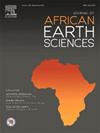Petrophysical and structural evaluation of the Jurassic Khatatba Formation (Lower Safa Member) in JG Field, Abu Gharadig Basin, Western Desert, Egypt
IF 2.2
4区 地球科学
Q2 GEOSCIENCES, MULTIDISCIPLINARY
引用次数: 0
Abstract
This research assessed the hydrocarbon prospectivity of the Lower Safa Member (Khatatba Formation) of the JG Field, Abu Gharadig Basin (AGB), Egypt, for future exploration in the AGB and comparable basins. Twenty-nine seismic lines and five wells' wireline logs (JG-8 ST, JG-5 ST, JG-1 ST, JG-13, and JG-16) were utilized to examine the reservoir's structural and petrophysical properties. Seismic interpretation provided a fault-controlled pattern of NE-SW and NW-SE striking normal faults that form 3-way dip closures. Petrophysical analyses revealed reservoir zones with net pay thicknesses up to 50 m, effective porosity of 13–21 %, low shale content of 2–10 %, hydrocarbon saturation of 50–95 %, and low BVW (0.01–0.08). Core photo analysis of the JG-8 well revealed six different lithofacies, e.g., laminated shales, silty shales, and well-sorted sandstones. These are in accordance with interpretations of various depositional environments, e.g., fluvial channels, deltaic distributary systems, and floodplain to marginal marine environments. These findings highlighted the multi-facies architecture and structural compartmentalization of the Lower Safa Member and demonstrated its strong reservoir potential and regional exploration significance.
埃及西部沙漠Abu Gharadig盆地JG油田侏罗系Khatatba组(下Safa段)岩石物性与构造评价
本研究对埃及Abu Gharadig盆地JG油田下Safa段(Khatatba组)的油气远景进行了评价,为今后在Abu Gharadig盆地及类似盆地的勘探奠定了基础。利用29条地震线和5口井的电缆测井(JG-8 ST、JG-5 ST、JG-1 ST、JG-13和JG-16)来检查储层的结构和岩石物理性质。地震解释提供了NE-SW和NW-SE走向的正断层控制模式,形成3向倾斜闭包。岩石物理分析表明,储层的净产层厚度可达50 m,有效孔隙度为13 - 21%,页岩含量为2 - 10%,烃饱和度为50 - 95%,BVW较低(0.01-0.08)。JG-8井岩心照片分析显示出6种不同的岩相,包括层状页岩、粉质页岩和分选良好的砂岩。这与各种沉积环境的解释相一致,如河流河道、三角洲分流体系、洪泛平原到边缘海洋环境。这些发现突出了下萨法段的多相构型和构造分区性,显示了其强大的储层潜力和区域勘探意义。
本文章由计算机程序翻译,如有差异,请以英文原文为准。
求助全文
约1分钟内获得全文
求助全文
来源期刊

Journal of African Earth Sciences
地学-地球科学综合
CiteScore
4.70
自引率
4.30%
发文量
240
审稿时长
12 months
期刊介绍:
The Journal of African Earth Sciences sees itself as the prime geological journal for all aspects of the Earth Sciences about the African plate. Papers dealing with peripheral areas are welcome if they demonstrate a tight link with Africa.
The Journal publishes high quality, peer-reviewed scientific papers. It is devoted primarily to research papers but short communications relating to new developments of broad interest, reviews and book reviews will also be considered. Papers must have international appeal and should present work of more regional than local significance and dealing with well identified and justified scientific questions. Specialised technical papers, analytical or exploration reports must be avoided. Papers on applied geology should preferably be linked to such core disciplines and must be addressed to a more general geoscientific audience.
 求助内容:
求助内容: 应助结果提醒方式:
应助结果提醒方式:


